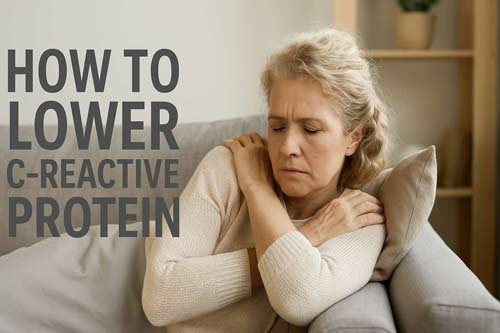How to Lower C Reactive Protein: Science-Backed Methods for Reducing Inflammation
Please like and subscribe if you enjoyed this video 🙂
Introduction
A healthy person’s C-reactive protein (CRP) typically measures around 1 mg/L, however, during acute illness, these levels can spike dramatically to 300 mg/L or higher. Indeed, high-sensitivity CRP (hs-CRP) levels above 3 mg/L signal increased cardiovascular risk, while readings at or above 10 mg/L indicate significant inflammation.
Research involving 376 participants revealed that 210 individuals diagnosed with coronary artery disease showed elevated CRP levels compared to their healthy counterparts. Furthermore, the American College of Cardiology and American Heart Association recognize hs-CRP levels of 2 mg/L and above as a potential risk factor for heart attacks.
The good news is that CRP levels can be effectively managed through various evidence-based approaches. From anti-inflammatory dietary changes to specific exercise protocols and lifestyle modifications, this article explores proven strategies for reducing CRP levels and managing inflammation effectively.
Understanding C-Reactive Protein and Inflammation
C-reactive protein (CRP) is a pentameric protein synthesized by the liver in response to pro-inflammatory cytokines during inflammatory processes. This acute-phase reactant derives its name from its ability to react with C-polysaccharide isolated from pneumococcal cell walls. Understanding CRP’s role in inflammation provides crucial insights into managing elevated levels effectively.
What CRP levels indicate about your health
CRP functions as a sentinel biomarker that signals underlying inflammation in the body. When measuring CRP levels, healthcare providers can assess:
-
Disease activity: CRP helps monitor inflammatory conditions such as rheumatoid arthritis, lupus, and inflammatory bowel disease
-
Infection severity: CRP levels rise within 4-6 hours after initial tissue injury and can increase several hundredfold within 24-48 hours
-
Cardiovascular risk: High-sensitivity CRP (hs-CRP) serves as a prognostic tool for heart disease, with levels above 3.0 mg/L indicating high cardiovascular risk
A remarkable finding is that high-sensitivity CRP predicts cardiovascular risk at least as well as cholesterol levels. Additionally, CRP testing provides valuable information for monitoring treatment effectiveness, as decreasing levels typically indicate that anti-inflammatory therapies are working.
How inflammation affects your body
Inflammation represents your body’s natural response to injury, infection, or toxins. Primarily governed by the immune system, this process dispatches white blood cells to affected sites. Nevertheless, inflammation presents as a double-edged sword:
Acute inflammation serves as a protective mechanism that initiates within hours of injury and typically resolves within days. This rapid response causes familiar symptoms like redness, pain, warmth, and swelling.
Chronic inflammation becomes problematic when it persists for months or years. This extended inflammatory state can attack healthy tissues throughout the body, subsequently raising the risk for serious conditions including heart disease, cancer, Alzheimer’s disease, diabetes, and autoimmune disorders. Notably, inflammatory diseases account for more than half of all deaths globally.
Normal vs. elevated CRP ranges
CRP measurements provide valuable clinical insights, with levels generally categorized as follows:
-
Less than 0.3 mg/dL: Normal level seen in most healthy adults
-
0.3 to 1.0 mg/dL: Minor elevation (can occur with obesity, pregnancy, depression, or smoking)
-
1.0 to 10.0 mg/dL: Moderate elevation (indicates conditions like rheumatoid arthritis, heart attack, or pancreatitis)
-
10.0 to 50.0 mg/dL: Marked elevation (suggests acute bacterial infections, viral infections, or major trauma)
-
Above 50.0 mg/dL: Severe elevation (associated with bacterial infections about 90% of the time)
For cardiovascular risk assessment, the hs-CRP test provides more precise measurements: less than 1.0 mg/L indicates low risk; 1.0-3.0 mg/L suggests moderate risk; and greater than 3.0 mg/L represents high risk for developing cardiovascular disease.

Dietary Changes to Lower CRP Naturally
Dietary modifications represent one of the most effective strategies for how to lower C reactive protein levels naturally. Research demonstrates that specific food choices can significantly impact chronic inflammation in the body.
Anti-inflammatory foods with proven benefits
Diet quality directly affects inflammatory markers, with certain foods showing remarkable ability to reduce CRP levels. The Low Inflammatory Foods Everyday (LIFE) diet, rich in dark green leafy vegetables, decreased mean plasma CRP by 0.47 mg/L in just one week. Similarly, a LIFE smoothie reduced CRP by 1.2 mg/L during the same period. Primarily, foods with established anti-inflammatory properties include:
-
Beta-carotene-rich vegetables: Spinach, kale, collard greens, and Swiss chard
-
Fatty fish: Salmon, mackerel, and sardines (containing EPA and DHA omega-3 fatty acids)
-
Berries: Particularly blueberries, which contain anthocyanins that reduce inflammation
-
Olive oil: Contains monounsaturated fats and polyphenols that fight inflammation
-
Nuts and seeds: Provide healthy fats, fiber, and anti-inflammatory compounds
Foods to avoid that increase inflammation
Conversely, certain dietary patterns heighten inflammation. Ultra-processed foods contributed almost 23% of total energy intake in one study, with the highest tercile consumption associated with 14% higher CRP levels in women. Specifically, avoid:
Refined carbohydrates: White bread, white rice, and processed snacksSugar-sweetened beverages: Soda and fruit juicesProcessed meats: Bacon, hot dogs, and sausagesTrans fats: Found in deep-fried foods and some processed products
Sample meal plan for reducing CRP
A practical daily menu based on anti-inflammatory principles might include:
Breakfast: Spinach omelet with turmeric; mixed berries; green tea Lunch: Salmon salad with olive oil dressing; quinoa; water Snack: Walnuts and apple slices Dinner: Vegetable and bean soup; leafy green salad; herbal tea
Despite its simplicity, this approach yields impressive results. Studies show that participants following anti-inflammatory diets dropped their CRP levels from around 7 mg/L to 1.75 mg/L within six months. Coupled with other lifestyle changes, these dietary modifications offer a powerful strategy for reducing inflammation and improving overall health.
Exercise Protocols That Reduce Inflammation
Regular physical activity stands among the most powerful natural interventions for reducing systemic inflammation. Research demonstrates that consistent exercise creates both immediate and long-term effects on inflammatory markers, including C-reactive protein.
Optimal exercise types for lowering CRP
Scientific evidence indicates that different forms of exercise affect inflammatory biomarkers through distinct pathways. Numerous studies have confirmed these exercise-specific effects:
-
Aerobic exercise shows the strongest evidence for CRP reduction, with multiple studies demonstrating significant decreases in inflammatory markers following consistent aerobic training. Research examining different exercise modalities found that joggers and aerobic dancers were significantly less likely to have elevated inflammatory markers compared with cyclists (OR = 0.33 and OR = 0.31, respectively).
-
Resistance training requires longer intervention periods to effectively lower CRP levels, with studies showing significant reductions after six months of supervised resistance training. For optimal results, high repetitions (12-20) with lower weights are recommended.
-
Combined protocols incorporating both aerobic and resistance training demonstrate compelling efficacy in reducing CRP levels in hypertensive patients. A 16-week supervised program of mixed aerobic and resistance training led to significant decreases in hs-CRP levels compared to control groups.
Finding the right intensity and duration
The anti-inflammatory benefits of exercise depend critically on proper intensity and duration:
Moderate exercise (30-60 minutes at 40-60% of maximal oxygen consumption) produces optimal anti-inflammatory effects. Remarkably, just 20 minutes of moderate exercise can trigger measurable anti-inflammatory responses at the cellular level.
Consequently, while intense long-duration exercise can potentially increase inflammatory markers in the short term, moderate exercise seems to provide the greatest inflammation-reducing benefits without triggering pro-inflammatory responses.
For most individuals, the ideal exercise prescription includes:
-
Target heart rate between 65-80% of maximum
-
20-60 minutes of aerobic activity 3-5 times weekly
-
Regular but not daily exercise, allowing recovery between sessions
-
Gradual progression in intensity and duration
Essentially, consistency matters more than intensity—longitudinal data tracking inflammatory markers over 10 years showed that habitually active participants maintained lower levels of inflammatory markers throughout the follow-up period.

Lifestyle Modifications for Long-Term CRP Reduction
Beyond diet and exercise, several additional lifestyle modifications effectively reduce C-reactive protein levels. These evidence-based strategies offer powerful tools for managing chronic inflammation.
Weight management strategies
Weight reduction directly correlates with decreased CRP levels. Research demonstrates that for each kilogram of weight lost, mean CRP levels decrease by 0.13 mg/L. This relationship remains consistent across multiple studies, with weight loss disproportionately lowering CRP compared to other cardiovascular risk factors.
In postmenopausal women, an average weight reduction of 14.5 kg (15.6%) resulted in a 32.3% decrease in CRP levels. Moreover, for individuals struggling with elevated inflammation:
-
Focus on sustainable weight loss rather than rapid reductions
-
Target modest initial goals (5% of body weight)
-
Prioritize fat loss, especially abdominal fat
Stress reduction techniques
Chronic stress triggers inflammatory responses that elevate CRP levels. Mindful meditation significantly reduced CRP among clinical trial participants. This reduction corresponds with decreased cortisol production, which otherwise disrupts endocrine function and elevates inflammatory markers.
Effective stress-management practices include 10-30 minutes of daily meditation, breathing exercises, and engaging in relaxing activities like gardening or music.
Sleep optimization
Sleep deprivation directly contributes to inflammation through multiple mechanisms. During normal sleep, blood pressure drops and blood vessels relax; without adequate rest, this process is disrupted, activating inflammatory pathways.
Poor sleep quality also impairs the brain’s glymphatic system, which normally clears inflammatory compounds during deep sleep phases. Even a single night of sleep loss can maintain elevated beta-amyloid levels, creating a vicious cycle of inflammation.
Smoking cessation and alcohol moderation
Smokers consistently show higher CRP levels than non-smokers. Although smoking cessation benefits aren’t immediately apparent, longitudinal studies reveal significant CRP reductions after four years of abstinence.
Interestingly, alcohol consumption exhibits a J-shaped relationship with inflammation—moderate intake (1 drink/day for women, 2 for men) decreases CRP levels by 35% compared to no consumption, while excessive drinking increases inflammation. Accordingly, those who consume alcohol 11-30 times monthly show a 26% lower likelihood of elevated CRP levels versus non-drinkers.


Conclusion
Managing C-reactive protein levels requires a comprehensive approach combining dietary modifications, targeted exercise protocols, and lifestyle adjustments. Research demonstrates that individuals who adopt anti-inflammatory diets while maintaining regular physical activity experience significant reductions in CRP levels, often dropping from 7 mg/L to 1.75 mg/L within six months.
Several key strategies have proven particularly effective:
-
Consuming beta-carotene-rich vegetables and omega-3 fatty acids
-
Engaging in moderate-intensity exercise for 20-60 minutes, 3-5 times weekly
-
Maintaining healthy sleep patterns and stress management practices
-
Achieving sustainable weight loss through balanced nutrition
Scientific evidence supports the long-term benefits of these interventions, especially when implemented consistently. Healthcare providers should note that CRP reduction strategies work synergistically – dietary changes enhance exercise benefits, while proper sleep optimizes inflammatory responses to physical activity.
Successful inflammation management depends on patient adherence to these evidence-based protocols. Regular monitoring of CRP levels helps track progress and adjust interventions accordingly, ensuring optimal outcomes for cardiovascular health and overall well-being.
Frequently Asked Questions:
FAQs
Q1. What are some effective ways to reduce C-reactive protein levels? Adopting an anti-inflammatory diet rich in fruits, vegetables, whole grains, and lean proteins can help lower CRP levels. Regular moderate exercise, stress reduction techniques, and maintaining a healthy weight are also effective strategies.
Q2. How quickly can I lower my CRP levels? While there’s no instant fix, consistent lifestyle changes can yield significant results. Some studies show that following an anti-inflammatory diet can reduce CRP levels from 7 mg/L to 1.75 mg/L within six months when combined with other healthy habits.
Q3. Are there specific foods that can help lower CRP? Yes, certain foods have shown promise in reducing inflammation. Beta-carotene-rich vegetables like spinach and kale, fatty fish high in omega-3s, berries, olive oil, and nuts are all beneficial for lowering CRP levels.
Q4. Can exercise help reduce C-reactive protein? Absolutely. Regular moderate exercise, particularly aerobic activities, has been shown to significantly lower CRP levels. Aim for 20-60 minutes of moderate-intensity exercise 3-5 times per week for optimal anti-inflammatory benefits.
Q5. Does sleep affect C-reactive protein levels? Yes, sleep quality and duration play a crucial role in managing inflammation. Poor sleep can disrupt the body’s natural anti-inflammatory processes, while adequate, quality sleep helps maintain lower CRP levels. Aim for 7-9 hours of sleep per night to support healthy CRP levels.
